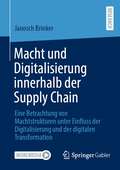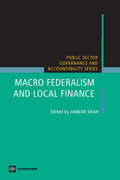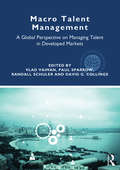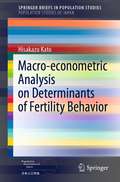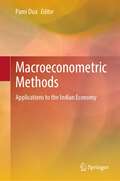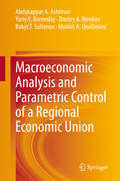- Table View
- List View
Machines, Bodies and Invisible Hands: Metaphors of Order and Economic Theory in Adam Smith
by Stefano FioriWhat was Adam Smith’s intellectual laboratory? How did his economic theory take shape? Were his metaphors of order only residual and ornamental expressions? This book answers these questions by analyzing the formation of the concepts of market and social order in Adam Smith’s work, by considering various aspects of his approach. It analyzes how metaphors and pre-analytical concepts influenced Smith’s theory. In line with studies that deal with the cognitive role of metaphors in science, this book suggests that in Smith’s work metaphors provided a framework, on which basis the theory subsequently developed. Therefore, as such they were part of that intellectual process which made possible the formation of structured concepts. The content and scope of the book permits a more comprehensive interpretation of Smith’s thought, in which many aspects of his work are taken into consideration in order to explain a crucial problem for Smith: the nature and causes of social and economic order. The book also shows that in general, formation of theories is a complex process that includes pre-analytical views as non-residual parts of inquiry.
Macht und Digitalisierung innerhalb der Supply Chain: Eine Betrachtung von Machtstrukturen unter Einfluss der Digitalisierung und der digitalen Transformation
by Janosch BrinkerIn diesem Buch wird ein Theorieansatz zur Beschreibung der Auswirkungen der Digitalisierung auf die Machtstrukturen innerhalb von Supply Chains erarbeitet. Hierzu nutzt die Forschung einen Design Science Research Ansatz und verknüpft innerhalb dieses qualitative Interviews, einen systematischen Literatur Review und eine Fallstudienanalyse, um die Machtdynamik in einer digitalisierten SCM-Landschaft zu analysieren. Anhand von 15 Experteninterviews und umfassenden Fallstudien entwickelt der Autor einen designtheoretischen Ansatz, der Einblicke in die Art und Weise bietet, wie die Digitalisierung die Machtverteilung, Strategien und Interaktionen innerhalb von Lieferketten beeinflusst, und schließt damit die Forschungslücke in diesem Bereich.Auf dieser Basis wird ein dreistufiges Supply Chain Modell entwickelt, um die Interaktionen zwischen Insidern, Outsidern und dem digitalen Rückgrat der Lieferkette darzustellen. Die Ergebnisse erarbeiten einen Wandelungsprozess in der Vorstellung von Macht für das Supply Chain Management und tragen so zur Weiterentwicklung der Supply-Chain-Management-Theorie in der digitalen Transformation bei. Hierzu beleuchtet die Arbeit die komplexe Beziehung zwischen Machtstrukturen und Digitalisierung innerhalb von Lieferketten.
Macht und Einfluss mit Weber, Einstein, Sophokles & Co.
by James McGrathDas Buch "Macht und Einfluss mit Weber, Einstein, Sophokles & Co." aus der Reihe "Management Short Cuts" versammelt 6 Zitate von Business-Gurus und bekannten Persönlichkeiten. Bei jedem Zitat wird erklärt, was es bedeutet, wie Sie es nutzen können und welche Fragen Sie sich stellen sollten. Kurz, kompakt und auf den Punkt können Sie so schnell die Kernbotschaft erfassen und anwenden. Sie erhalten wertvolle Einblicke und Kenntnisse für Ihren Erfolg!
Macht, Kontrolle und Entscheidungen in Organisationen: Eine Einführung in organisationale Mikro-, Meso- und Makropolitik (Studientexte zur Soziologie)
by Thomas MatysDiese Einführung stellt die grundlegenden organisationstheoretischen Ansätze und Theoriestränge dar, die Macht, Kontrolle und Entscheidungen in und durch Organisationen zum Inhalt haben. Die Wechselwirkungen des handelnden Subjekts innerhalb der Macht-, Kontroll- und Entscheidungsmodi sowie die Entstehung und Definition des Machtbegriffes werden eingehend beschrieben. Durch eine Analyse mikro-, meso- und makropolitischer Ordnungsraster werden arbeits- und organisationssoziologische Diskurse, die innerhalb organisationaler Macht-, Kontroll- und Entscheidungskontexte relevant sind und bis zur „digitalen Transformation“ reichen, aufgezeigt.
Macro Federalism and Local Finance
by Anwar M. ShahThe design of a federal system to deal with growth, stabilization, and regional and local development issues is the primary concern of this volume, edited by Anwar Shah. The book provides analytical tools to address issues arising from globalization, localization, and regional integration. It discusses tax harmonization issues associated with subnational value added tax administration. It provides a framework for fiscal discipline in a federal system. Lessons from international experiences from policies to deal with lagging regions are drawn. The book empirically examines the effect of fiscal decentralization on the overall size of the public sector. Finally, it draws lessons from industrial countries' experiences on local governance. This important new series represents a response to several independent evaluations in recent years that have argued that development practitioners and policy makers dealing with public sector reforms in developing countries and, indeed, anyone with a concern for effective public governance could benefit from a synthesis of newer perspectives on public sector reforms. This series distills current wisdom and presents tools of analysis for improving the efficiency, equity, and efficacy of the public sector. Leading public policy experts and practitioners have contributed to the series.
Macro Innovation Dynamics and the Golden Age
by Paul J. J. WelfensThis book takes a new look at the golden age in neoclassical growth theory and explores in detail sustainability and optimum growth in China, the US and Europe. Innovation, foreign direct investment, trade and growth dynamics are key elements in modern economies - including perspectives on green growth and aspects of the knowledge production function in the context of multinational companies. As such the book considers the role of foreign direct investment in a modified growth model and discusses innovation in an enhanced Mundell-Fleming macro model. Moreover, for the first time it directly links a knowledge production function to the macro production function in a broader context, including real money balances in the production function. It shows - also with empirical relevance - that FDI inward stocks relative to the GDP of host countries, the number of researchers and per capita income are relevant drivers of new knowledge and the stock of knowledge, respectively. This new Schumpeterian theoretical approach lends itself to important policy conclusions for both OECD members and newly industrialized countries.
Macro Socio-economics: From Theory to Activism
by David SciulliContributors to this volume respond to the normative capsule framing economic behaviour that Amitai Etzioni has explored. The text also looks at his works on organisations, public policy, socio-economics and communitarianism.
Macro Talent Management in Emerging and Emergent Markets
by Paul Sparrow Randall Schuler Vlad Vaiman David G. Collings<p><i>Macro Talent Management in Emerging and Emergent Markets</i> is the first book to focus specificially on country-level activities that are aimed at attracting, developing, mobilizing, and retaining top talent for economic success in emerging or emergent markets. The book serves as a guide that orients the reader toward activities that increase their country’s global competitiveness, attractiveness, and economic development through strategic talent management. <p>This book brings together leading experts from around the world to address such issues as cross-border flows of talent, diaspora mobility, knowledge flows, global labour markets, and policies. The book is structured in three parts: Part I covers emerging markets, Part II emergent markets, and Part III pan-national themes such as migration and clusters. <p>Bringing together research from the fields of human resource management, international business, economic geography, comparative international development, and political economy, this is a definitive, comprehensive treatment of the topic aimed at advanced students and practitioners.</p>
Macro Talent Management: A Global Perspective on Managing Talent in Developed Markets (Routledge Global Human Resource Management Series)
by Paul Sparrow Randall Schuler Vlad Vaiman David G. Collings<p><i>Macro Talent Management: A Global Perspective on Managing Talent in Developed Markets</i> is the first book to focus specifically on country-level activities aimed at attracting, mobilizing, developing, and retaining top talent for economic success in developed markets. The book serves as a guide that orients the reader toward activities that increase their country's global competitiveness, attractiveness, and economic development through strategic talent management. <p>This book brings together leading experts from around the world to address such isues as cross-border flows of talent, diaspora mobility, knowledge flows, global labour markets, and policies. Bringing together research from the fields of human resource management, international business, economic geography, comparative international development, and political economy, this is a definitive, comprehensive treatment of the topic aimed at advanced students and practitioners.</p>
Macro-Financial Linkages in the Pacific Region
by Akira KohsakaGrowth perspectives in emerging market economies are increasingly dependent on international capital flows in recent decades because of their influences on business cycles. In fact, volatile international capital flows has been one of the main concerns for the macroeconomic policy authorities. Focusing on emerging economies in the Pacific region, this book reveals how they are different from those in other regions in terms of international macro-financial linkages to the global capital market and domestic financial development,. The book also discusses how these characteristics have interacted with their macroeconomic policy regimes and their macroeconomic performance throughout the two major international financial crises in the past more than two decades. It suggests facts that have strengthened the resilience of these emerging economies in the Pacific region against the global financial crisis along with the intensified intra-regional economic integration through trade and investment. The book also examines their macroeconomic management focusing on monetary policy regimes and suggests that their factual unorthodox policies with exchange rate management and capital controls have contributed to their resilience against the intrinsic volatility of the international capital market and financial flows.
Macro-Social Marketing Insights: Systems Thinking for Wicked Problems (Routledge Interpretive Marketing Research)
by Ann Marie KennedyMacro-social marketing is an approach to solving wicked problems. Wicked problems include obesity, environmental degradation, smoking cessation, fast fashion, gambling, and drug and alcohol abuse. As such, wicked problems are those problems that are so complex and multifaceted, it is difficult to define the exact problem, its contributing factors, and paths to a solution. Increasingly, governments, NGOs, and community groups are seeking to solve these types of problems. In doing so, the issues with pursuing macro-level change are beginning to emerge. Issues stem from the interconnected nature of stakeholders involved with a wicked problem—where one change may create a negative ripple effect of both intended and unintended consequences. Macro-social marketing, then, provides a holistic and systemic approach to both studying and solving wicked problems. Within the chapters of this book, macro-social marketing approaches to analysing and defining wicked problems, to identifying stakeholders and potential ripple effects, and to implementing macro-level change are presented. In this emerging area of academia, the theories, models, and approaches outlined in this book are cutting edge and provide a critical approach from top researchers in the area. Both practical and theoretical aspects are presented as well as caveats on such societal and/or country-wide change. A must-have for social marketing academics and those interested in macro-level change at a practical or theoretical level.
Macro-control and Economic Development in China (China Perspectives)
by Jiagui ChenThis book, together with Economic Development and Reform Deepening in China is a collection of papers written in recent years about maintaining economic growth, managing inflation, the relationship between growth and structural adjustment, control of price growth, maintaining stable economic development, and other relevant aspects of macro-control, economic development, and deepening reform. Chinese government adopts many of the recommendations put forward by the book.
Macro-econometric Analysis on Determinants of Fertility Behavior (SpringerBriefs in Population Studies)
by Hisakazu KatoThe book comprises three chapters, with each chapter assigned various type data such as time series data, cross sectional data and panel data. The purpose of this book is to explore the economic and social determinant factors of fertility. Unlike many previous empirical analyses of fertility and the related demographic events, this research has three characteristics. The first is that the relationship between fertility and labor participation by females is thoroughly considered, with much discussion about the structural change between those factors. The second is that time series analysis such as the Bayesian vector autoregressive (BVAR) model or co-integration concepts is applied to explore the determinant factors of fertility. The third is that the effectiveness of public policies related to improve fertility is confirmed. In recent years, micro-econometric analysis has become popular; however, this book takes another approach from the perspective of macro- or semi-macro-econometrics.
Macro-economic Policy: A Comparative Study, Australia, Canada, New Zealand and South Africa (Routledge Library Editions: Macroeconomics)
by J. O. N. PERKINS, M. D. ENGLISH, J. P. NIEUWENHUYSEN AND J. W. ROWEWhen it was first published in 1972, this was the first book to analyze the experience of Australia, Canada, New Zealand and South Africa in the field of macro-economic policy. The characteristics of this group of countries gives them much in common with both industrialized and emerging economies. Their experience of economic policy-making has, therefore an unusually wide relevance.
MacroMarkets LLC
by Robin Greenwood Luis M. ViceiraMacroMarkets co-founder and CEO Samuel Masucci III is meeting with a strategic partner for his firm. Co-founded with Yale University Professor Robert Shiller, MacroMarkets' main innovation is the "MacroShare," which allows investors to take long or short, levered or unlevered, positions based on the value of any index. Both Shiller and Masucci are hopeful that MacroShares can help investors hedge all kinds of macroeconomic risks, including exposure to residential housing. The firm has 'battle-tested' two products-- one linked to oil, and one linked to housing -- with mixed success, and is evaluating its strategy going forward. Specifically, Masucci wonders whether the MacroShare structure might come to replace the ETF as the predominant technology for index trading.
MacroMarkets LLC
by Robin Greenwood Luis M. ViceiraMacroMarkets co-founder and CEO Samuel Masucci III is meeting with a strategic partner for his firm. Co-founded with Yale University Professor Robert Shiller, MacroMarkets' main innovation is the "MacroShare," which allows investors to take long or short, levered or unlevered, positions based on the value of any index. Both Shiller and Masucci are hopeful that MacroShares can help investors hedge all kinds of macroeconomic risks, including exposure to residential housing. The firm has 'battle-tested' two products-- one linked to oil, and one linked to housing -- with mixed success, and is evaluating its strategy going forward. Specifically, Masucci wonders whether the MacroShare structure might come to replace the ETF as the predominant technology for index trading.
Macrodynamics: A study of the economy in equilibrium and disequilibrium
by Pierre-Yves HéninBuilding from the micro-foundations of economic behaviour to a full survey of macroeconomics, the book examines growth theory and equilibrium and disequilibrium approaches to provide a comprehensive survey of all the rival theoretical approaches that underlie central policy debates. A survey of pre-Keynesian theories of growth, fluctuations and the various short and long cycles and crises is followed by an exposition of Keynesian theory and its subsequent development and of the neo-classical revival. Topics covered include: * Non-clearing markets * Involuntary unemployment * Persistent inflation. As well as full coverage of the English-language literature, Macrodynamics covers important contributions from the new school of French macroeconomists, including Malinvaud, Benassy and Grandmont.
Macroeconometric Methods: Applications to the Indian Economy
by Pami DuaThis book provides empirical applications of macroeconometric methods through discussions on key issues in the Indian economy. It deals with issues of topical relevance in the arena of macroeconomics. The aim is to apply time series and financial econometric methods to macroeconomic issues of an emerging economy such as India. The data sources are given in each chapter, and students and researchers may replicate the analyses.The book is divided into three parts—Part I: Macroeconomic Modelling and Policy; Part II: Forecasting the Indian Economy and Part III: Business Cycles and Global Crises. It provides a holistic understanding of the techniques with each chapter delving into a relevant issue analysed using appropriate methods—Chapter 1: Introduction; Chapter 2: Macroeconomic Modelling and Bayesian Methods; Chapter 3: Monetary Policy Framework in India; Chapter 4: Determinants of Yields on Government Securities in India; Chapter 5: Monetar y Transmission in the Indian Economy; Chapter 6: India’s Bilateral Export Growth and Exchange Rate Volatility: A Panel GMM Approach; Chapter 7: Aggregate and Sectoral Productivity Growth in the Indian Economy: Analysis and Determinants; Chapter 8: Forecasting the INR/USD Exchange Rate: A BVAR Framework; Chapter 9: Forecasting India’s Inflation in a Data-Rich Environment: A FAVAR Study; Chapter 10: A Structural Macroeconometric Model for India; Chapter 11: International Synchronization of Growth Rate Cycles: An Analysis in Frequency Domain; Chapter 12: Inter-Linkages Between Asian and U.S. Stock Market Returns: A Multivariate GARCH Analysis; Chapter 13: The Increasing Synchronization of International Recessions.Since the selection of issues is from macroeconomic aspects of the Indian economy, the book has wide applications and is useful for students and researchers of fields such as applied econometrics, time series econometrics, financial econometrics, forecasting methods and macroeconomics.
Macroeconometric Models
by Władysław WelfeThis book gives a comprehensive description of macroeconometric modeling and its development over time. The first part depicts the history of macroeconometric model building, starting with Jan Tinbergen's and Lawrence R. Klein's contributions. It is unique in summarizing the development and specific structure of macroeconometric models built in North America, Europe, and various other parts of the world. The work thus offers an extensive source for researchers in the field. The second part of the book covers the systematic characteristics of macroeconometric models. It includes the household and enterprise sectors, disequilibria, financial flows, and money market sectors.
Macroeconomic Accounting and Analysis in Transition Economies
by Subhash Thakur Abdessatar OuanesA report from the International Monetary Fund.
Macroeconomic Adjustment in a Highly Dollarized Economy: The Case of Cambodia
by Mario De Zamaróczy Sopanha SaA report from the International Monetary Fund.
Macroeconomic Analysis
by Dirk NiepeltA concise but rigorous and thorough introduction to modern macroeconomic theory.This book offers an introduction to modern macroeconomic theory. It is concise but rigorous and broad, covering all major areas in mainstream macroeconomics today and showing how macroeconomic models build on and relate to each other. The self-contained text begins with models of individual decision makers, proceeds to models of general equilibrium without and with friction, and, finally, presents positive and normative theories of economic policy. After a review of the microeconomic foundations of macroeconomics, the book analyzes the household optimization problem, the representative household model, and the overlapping generations model. It examines risk and the implications for household choices and macroeconomic outcomes; equilibrium asset returns, prices, and bubbles; labor supply, growth, and business cycles; and open economy issues. It introduces frictions and analyzes their consequences in the labor market, financial markets, and for investment; studies money as a unit of account, store of value, and medium of exchange; and analyzes price setting in general equilibrium. Turning to government and economic policy, the book covers taxation, debt, social security, and monetary policy; optimal fiscal and monetary policies; and sequential policy choice, with applications in capital income taxation, sovereign debt and default, politically motivated redistribution, and monetary policy biases. Macroeconomic Analysis can be used by first-year graduate students in economics and students in master's programs, and as a supplemental text for advanced courses.
Macroeconomic Analysis and Economic Policy Based on Parametric Control
by Askar A. Ashimov Abdykappar A. Ashimov Robert M. Nizhegorodtsev Dmitriy A. Novikov Yuriy V. Borovskiy Zheksenbek M. Adilov Bahyt T. SultanovAfter the transition to free economy, governments of the former Soviet republics realized that in spite of becoming a part of the shaky international economic order, their individual economic success can be assured by rational national economic policies that in addition to the fundamental law of supply and demand govern the economic mechanism sensitive to both external and internal phenomena. Originally published in Russian and now translated in English, this book by Dr. A. Ashimov and his colleagues offers a novel theory providing a numerically-justifiable approach to the solution of major economy control problems that are faced by virtually every government in the world. First, they developed and validated numerous mathematical models describing complex interactions between economic and social factors thus enabling the decision makers to foresee the outcomes of their decisions. Second, on the basis of these models the authors formulated the appropriate control problems that could be interpreted as achieving the transition to the desirable economic regimes and maintaining these regimes in spite of initial conditions and both external and internal perturbations. It should be noted that due to the inherent uncertainty introduced by the use of statistical models, the nonlinearity of the underlying phenomena and the intention to obtain the optimal solutions, the solution process becomes quite intricate and calls for the application of the most sophisticated techniques offered in advanced control theory. The authors utilized the most instrumental statistical model validation techniques; they established sufficient conditions for the existence of optimal solutions of the relevant control problems; and they skillfully combined the applications of the phase space formalism, system stability analysis, and the methods of functional analysis. Finally, they developed algorithms resulting in the optimal problem solutions, thus offering economic policy makers a dependable decision support tool. Macroeconomic Analysis and Economic Policy Based on Parametric Control offers a novel, highly mathematical approach to the solution of very realistic economy control problems. It presents a good example of the application of mathematical modeling, advanced control theory, and model-based decision making that could be adopted by researchers and graduate students specializing in economics, control, and relevant areas of research, addressing their own research problems.
Macroeconomic Analysis and Parametric Control of a National Economy
by Askar A. Ashimov Abdykappar A. Ashimov Dmitriy A. Novikov Yuriy V. Borovskiy Zheksenbek M. Adilov Bahyt T. Sultanov Rakhman A. AlshanovThis is a sequel to the book by Dr. A. Ashimov and his colleagues, Macroeconomic Analysis and Economic Policy Based on Parametric Control. The authors have expanded both the developed mathematical apparatus and the scope of problems and applications stemming from the practice of steering a national economy of a small country in the dynamic environment of the international economic order. The developed theoretical foundation is used in Chapter 1 to suggest a decision support system operating in the framework of state economic policy making. Chapter 2 presents various mathematical models built on the basis of the available statistical data and provides quality assessment of these models. Parametric control problems are being formulated on the basis of these models as problems of mathematical programming, and the obtained solutions are subjected to analyses and interpretations. This is demonstrated by the analysis of the effect of uncontrollable factors on the problem solutions. Chapter 3 is aimed at the modelling and analysis of cyclic phenomena in economics and their structural stability. Chapter 4 presents solutions of specific problems of national economy and analysis and interpretation of their solutions. In summary, the authors formulate comprehensive mathematical models of some critical mechanisms in micro economics previously known only on a qualitative level. They provide vigorous mathematical analysis of the models that justifies their applicability for the formulation of parametric control problems, and the existence of model-based solutions. The complexity of the resultant problems is addressed by the formulation of the appropriate algorithms. The described methodology leads to the development of computer-based decision support systems.
Macroeconomic Analysis and Parametric Control of a Regional Economic Union
by Abdykappar A. Ashimov Yuriy V. Borovskiy Dmitry A. Novikov Bakyt T. Sultanov Mukhit A. OnalbekovThis book is a further development of the theory of parametric control. It includes: numerical methods of testing (verification) of software implementation of mathematical models by assessing the stability of mappings defined by the model; sufficient conditions for the existence of the solutions of some types of problems of dynamic optimization; the existence of continuous dependence of optimal values of criteria on exogenous functions and parameters; and the existence of points of bifurcation of extremals of such problems. It demonstrates that this theory offers a constructive methodology for middle-term forecasting, macroeconomic analysis and estimation of optimal values of economic characteristics on the basis of advanced global mathematical models, namely Computable General Equilibrium (CGE) Model, Dynamic Stochastic General Equilibrium (DSGE) Model, and Hybrid Econometric model. In addition, it includes conditions for the applicability of the computational experiments’ results, into practice.

